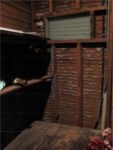 Robert Warren, Executive Director of the Hoyt Sherman Place gallery in Des Moines, Iowa, was looking for some Civil War flags in a flower closet. He didn’t find any. Instead, wedged between a table and the wall, he found a late 16th century panel painting by Dutch master Otto van Veen. It had suffered significant water damage after spending who knows how long in a small, uninsultated room full of jumbled stuff, and before then experienced unfortunate attempts at restoration. It was also unsigned.
Robert Warren, Executive Director of the Hoyt Sherman Place gallery in Des Moines, Iowa, was looking for some Civil War flags in a flower closet. He didn’t find any. Instead, wedged between a table and the wall, he found a late 16th century panel painting by Dutch master Otto van Veen. It had suffered significant water damage after spending who knows how long in a small, uninsultated room full of jumbled stuff, and before then experienced unfortunate attempts at restoration. It was also unsigned.
The scene depicts the figures of Apollo and Venus accompanied by her son Cupid. Venus, the Roman Goddess of Love, Beauty, and Fertility, is portrayed as an artist painting a landscape that includes a small image of Pegasus on the horizon. Apollo, holding a lyre, is the Roman God of Music, Poetry, and more. Cupid is the Roman God of Desire, Affection, and Erotic Love. The painting also contains four still-lifes referencing Venus’ beauty and fertility: a collection of jewelry, a basket of fruit and flowers, a sprig of roses, and a bowl of oysters. A fifth still-life of her painting supplies occupies the lower right corner.
The painting was coated with layers of discolored varnish and former restoration work that flattened the three-dimensional quality of the scene and falsified the artist’s intended palette. Areas of former loss were present along splits in the wood and throughout scattered areas especially pronounced in the left third of the painting. The surface was heavily overpainted after a succession of former restoration attempts.
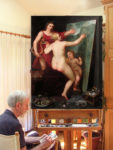 Chicago conservator Barry Bauman conserved the piece, cleaning it, repairing flaking paint and faulty restorations. The artist was identified as Otto van Veen who painted it in Antwerp in the last years of the 16th century. It was brought to Des Moines by the Collins family who had owned it since at least the 1880s when they lived in New York and loaned it to the Metropolitan Museum of Art. The painting moved to Des Moines with them and the family donated it to the Hoyt Sherman Place gallery in the 1923. It is Des Moines’ earliest Old Master painting.
Chicago conservator Barry Bauman conserved the piece, cleaning it, repairing flaking paint and faulty restorations. The artist was identified as Otto van Veen who painted it in Antwerp in the last years of the 16th century. It was brought to Des Moines by the Collins family who had owned it since at least the 1880s when they lived in New York and loaned it to the Metropolitan Museum of Art. The painting moved to Des Moines with them and the family donated it to the Hoyt Sherman Place gallery in the 1923. It is Des Moines’ earliest Old Master painting.
Born in Leiden to a prominent Catholic family, van Veen studied in Rome and built a successful studio in Antwerp where he received numerous commissions for altar pieces and other religious themed works from churches and aristocratic patrons. He also took in students, most famously Peter Paul Rubens who studied under van Veen from 1594 to 1600, just the time when he painted Apollo and Daphne. A humanist and scholar, van Veen would go on to publish three emblem books (illustrated compendia of symbols and allegories used in art accompanied by a motto from a famous author, usually from antiquity). His most popular by far was Amorum emblemata (published in 1608), which is replete with Cupids.
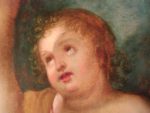 So even though Apollo and Venus might seem to lean towards the profane for someone with a thriving business painting Christian iconography, in fact it fits his education, understanding and pedagogical approach to perfection. There are so many symbols of love layered in the panel it would have made a very useful addition to the Amorum emblemata.
So even though Apollo and Venus might seem to lean towards the profane for someone with a thriving business painting Christian iconography, in fact it fits his education, understanding and pedagogical approach to perfection. There are so many symbols of love layered in the panel it would have made a very useful addition to the Amorum emblemata.
All those layers may be the reason the masterpiece was hidden away in the storage closet. When it was donated to the gallery, the Hoyt Sherman Place was run by the upstanding ladies of the Des Moines Women’s Club. They founded the Club in 1885 with the express purpose of creating an art museum open to the public free of charge. After more than two decades of hosting temporary exhibitions at various sites, in 1907 the DMWC finally found a permanent home when the city rented them the historic Hoyt Sherman Place for the token sum of $1 a year. The Club built an addition to house its art collection and the Hoyt Sherman Place gallery opened as the first public art gallery in Des Moines.
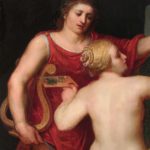 In 1921 construction began on another addition that would expand the gallery and create an elegant auditorium for performances and exhibitions. The closet where Warren discovered the Van Veen’s masterpiece is located on the balcony of the auditorium. He speculates that all the nudity, sex and fertility symbols were a little too spicy for the Des Moines Women’s Club when it was donated in the 1920s. At that time, there wasn’t a single nude in the 54-work collection.
In 1921 construction began on another addition that would expand the gallery and create an elegant auditorium for performances and exhibitions. The closet where Warren discovered the Van Veen’s masterpiece is located on the balcony of the auditorium. He speculates that all the nudity, sex and fertility symbols were a little too spicy for the Des Moines Women’s Club when it was donated in the 1920s. At that time, there wasn’t a single nude in the 54-work collection.
Apollo and Venus debuted at the gallery in a preview last month. It will be displayed as part of the permanent collection this summer.
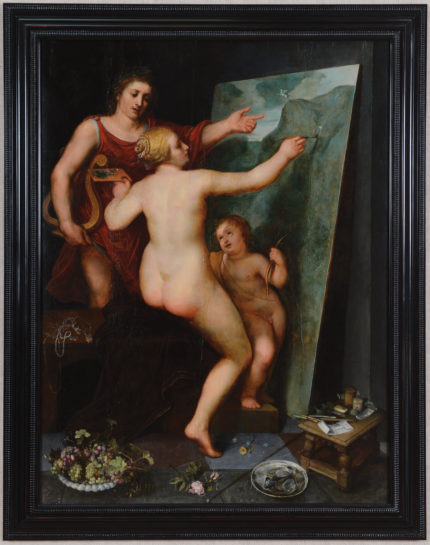
Oh no, a Venus, quick, grab your pearls…!
Those ‘flowers’ in the ‘basket of grapevine’ seem to be vine leafs, while the leafs on the ‘sprig of roses’ are clearly rose leafs. In that bowl of oysters there are also mytilidae, which both are harvested today near Antwerp. Underneath of vine, roses and mussels there are golden letters (in Latin?) and a billiard cue. Thus, I wonder, where (and why) the ‘Pegasus’ take-off comes into play :confused:
It seems as if the text was first, then the cue and finally the mussel bowl painted over it. Unfortunately, I cannot say if all this is sheer coincidence or if there was possibly an idea behind it, i.e. a play of words or some sort of riddle. The ‘O’ underneath the mussels, e.g., might stand for ‘Otto’, while hidden underneath the roses there might be the real name of that.. “Veenus” – Of course, this only is a first wild guess.
In Greek mythology, Hippocrene (Ἱππου κρήνης or ‘Horse’s Fountain’) was a spring on Mt. Helicon, sacred to the Muses and formed by the hooves of Pegasus.
The water was supposed to bring forth poetic inspiration when imbibed. What you also need as an artist, is of course girls, mussels and vine.
Methinks that’s not a billiard cue. It’s the stick that an artist uses to brace his/her hand whilst painting.
Agreed. A maul stick or wrist rest.
Very good point(s).
I had assumed that the “cue” -which made perfect sense to me- was continued in the “black space” in the background, which is of course only the wall that the painting is leaning against.
Also, I had frankly no idea about a ‘maul baum’ or ‘mahl stock’. There are pictures where they have a cushion on top, similar to the one on that table.
The inscription is a Latin quote, if I’m reading this article correctly: https://hyperallergic.com/436001/otto-van-veen-painting-rediscovered-iowa-storeroom/
“There was an inscription you could see on the bottom of the uncleaned version, through X-rays, Warren said. “We thought it was going to be the artist’s signature, but in fact it’s a Latin quote — which was one of Otto van Veen’s signatures.”
If someone X-rayed this, I really would like to know the text of that Latin inscription, as I was trying to find it elsewhere, but to no avail.
I would agree that it either relates to Otto, to art in general, to both deities, mussels and vine or to Hesiod’s ‘Theogony’, i.e. the creation of the gods and the muses (Pegasus and Mount Helicon, bathing in holy rivers like the Hippocrene etc.),
…whose first eight lines of its proem read:
Μουσάων Ἑλικωνιάδων ἀρχώμεθ’ ἀείδειν,
αἵ θ’ Ἑλικῶνος ἔχουσιν ὄρος μέγα τε ζάθεόν τε,
καί τε περὶ κρήνην ἰοειδέα πόσσ’ ἁπαλοῖσιν
ὀρχεῦνται καὶ βωμὸν ἐρισθενέος Κρονίωνος·
καί τε λοεσσάμεναι τέρενα χρόα Περμησσοῖο
ἠ’ Ἵππου κρήνης ἠ’ Ὀλμειοῦ ζαθέοιο
ἀκροτάτῳ Ἑλικῶνι χοροὺς ἐνεποιήσαντο,
καλοὺς ἱμερόεντας, ἐπερρώσαντο δὲ ποσσίν.
Ah, on the X-rayed bottom, I thought it meant the X-rated bottom…
PLEEEAASE! :ohnoes: For Apollon’s sake!…
What is the stupid ‘Latin quote — which was one of Otto van Veen’s signatures’? Ok, if I understood at least Chris’ linked webpage correctly, one of Otto’s [other] signatures are rosy female bottom cheeks :boogie:
However, if we suppose that the vine, the roses and the mussels are part of the mystery (i.e. mysterious to me) Latin quote, I can come up now with just another wild uneducated guess:
———-
1.) Brac(c)hiolum (Maulstick), Bacchus
2.) Dirigit, Roses
3.) O(ttonem/ Oyster/ Ostrea)
———-
Thus, ‘if a vine [or roses] be to climb trees [or paintings be created] that are of any great height, there would be stays and appuies set to it’ [as they are set to would-be farmed oysters], or in other words, “B(r)ac(c)hiolum Dirigit O(ttonem)” 😆